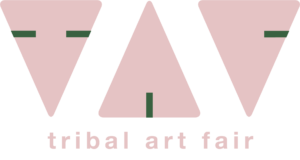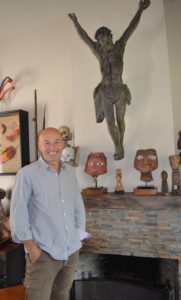Steffen Patzwahl
This wooden Asmat substitute head comes from Mata Hari’s collection.
For 25 years, Steffen Patzwahl has been the zoological director of Pairi Daiza, a zoo, botanical garden and ethnographic museum rolled into one. The park is vast; you can easily while away a whole day there.
If you enter Pairi Daiza and visit the first toilet, the first thing you will realise is that it is a very unique park. The whole area is decorated with traditional money from all over the world, such as a feather roll of money from the Solomon Islands and a large money stone from Yap among many others. Because the toilets are somewhere everyone visits, Steffen wanted to turn them into something special. There is also a toilet in the aquarium, where you literally sit amongst the fish.
The park is located on the site of a 12th-century abbey and special abbey beer is still brewed there today. Work is currently underway on a first hotel-project and a new shelter for the polar bears. In the park, plants and animals are presented in their natural environment as much as possible. That’s why Steffen travelled to Canada, where he gained inspiration for the design of vast bear and wolf enclosures by visiting their natural habitat. He also enjoys working together with local specialists on the design of new living environments. On Vancouver Island, for example, totem poles were made for the park. And one of the temples from the Kingdom of Ganesha, made by craftsmen from Bali, has just been consecrated by 10 Balinese priests.
Steffen lives in the park and his passion for ethnography and the animal kingdom can be seen all over his house. A large albatross appears to be flying off from the ceiling, shields from Australia are visible in the alcove by the window and a collection of korwars adorns the mantelpiece. There are also axes and clubs from Oceania, a bowl with nose bones and other small ethnographic objects to admire. The table is full of books. Ever since he was a boy, he’s been interested in everything related to nature. The stones, feathers and bones that he found outside when he was a child came with him to the house. He was introduced to ethnography by an old collector from his village.
Steffen is mainly interested in objects from Oceania and South America. He has a large number of adorned and treated skulls. These skulls tell him something about how people deal with life and death in different cultures, something which he is also regularly confronted with in his work in the zoo. Between the skulls is an Asmat substitute head from Mata Hari’s collection. He also has a shrunken head, a so-called tsantsa, from the Jivaro tribes of Ecuador and Peru. The heads were trophies that were used during rituals. One of the other shrunken heads from Steffen’s collection was collected by the Marquis de Wavrin, a Belgian adventurer ,filmmaker and anthropologist who left for South America at the start of the 20th century and became very involved in the Jivaroan culture.
When Steffen started collecting, he sometimes bought objects whose authenticity he later started to doubt. But he sees this as the inevitable, almost like the dues you have to pay as a collector in order to gain knowledge and train your eye.
One of his favourite objects is a small korwar. The ancestral sculpture has an especially characterful expression and the wood glistens slightly if the sun catches it in a certain way. But he also has a personal connection with many other objects from his collection. He made a special purchase during a trip through Papua New Guinea, namely a bracelet made from a jaw, which he found in a supermarket. This had been left behind as payment for tobacco.
Last year, Steffen Patzwahl visited the Tribal Art Fair for the first time and was pleasantly surprised. He was impressed by the building, great atmosphere and very diverse range of objects on offer. It’s therefore very likely that he’ll be returning to the fair this year.
Steffen Patzwahl
Dit houten een Asmat substituut hoofd komt uit de collectie van Mata Hari.
Steffen Patzwahl is al 25 jaar zoölogisch directeur van Pairi Daiza, een dierentuin, botanische tuin en etnografisch museum in een. Het park is ruim opgezet, je kunt er makkelijk een hele dag vertoeven.
Wanneer je Pairi Daiza binnenkomt en naar de eerste wc gaat die je tegenkomt, merk je meteen hoe bijzonder het park is. De hele ruimte is ingericht met traditioneel geld van over de hele wereld, zoals een verengeldrol uit de Salomons eilanden en een grote gelsteen uit Yap en nog veel meer andere voorwerpen. Omdat de toiletten een plek is die iedereen bezoekt wilde Steffen juist daar iets bijzonders van maken. Zo is er ook een wc te vinden in het aquarium en daar zit je letterlijk tussen de vissen.
Het park is gevestigd op het terrein van een 12de eeuwse abdij en er wordt nog steeds speciaal abdijbier gebrouwen. Momenteel wordt er ook hard gewerkt aan het eerste hotel op het park en aan een nieuw onderkomen voor de ijsberen. In het park worden planten en dieren zoveel mogelijk gepresenteerd in hun natuurlijke leefomgeving. Daarom reisde Steffen, ter inspiratie voor de inrichting van een groot terrein voor de beren en wolven, naar Canada om daar hun leefgebied te bezoeken.
Ook werkt hij bij het ontwerpen van nieuwe leefwerelden graag samen met lokale specialisten. Zo worden er in Vancouvereiland totempalen voor het park gemaakt. En één van de tempels uit het Koninkrijk Ganesha, gemaakt door ambachtslieden uit Bali, is net ingewijd door 10 Balinese priesters.
Steffen woont op het park en in zijn huis is overal zijn passie voor etnografica en het dierenrijk te zien. Aan het plafond vliegt een grote albatros, in de alkoof bij het raam
hangen schilden uit Australië en op de schouw staat een collectie korwars. Verder zijn er onder andere bijlen en knotsen uit Oceanië, een schaal met neusbotten en andere kleine etnografische objecten te bewonderen. De tafel ligt vol boeken.
Hij is al van jongs af aan geïnteresseerd in alles wat met de natuur te maken heeft. De stenen, veren en botjes die hij als kind buiten vond nam hij mee naar huis. Met de etnografica maakte hij kennis door een dorpsgenoot die een verzameling daarvan had.
Steffens interesse gaat vooral uit naar objecten uit Oceanië en Zuid-Amerika. In zijn verzameling heeft hij een groot aantal versierde en bewerkte schedels. Deze schedels vertellen hem iets over hoe men in de verschillende culturen omgaat met leven en dood, iets waar hij in zijn werk in de dierentuin ook regelmatig mee geconfronteerd wordt. Tussen de schedels staat een Asmat substituut hoofd uit de collectie van Mata Hari. Ook heeft hij een shrunken head, een zgn. tsantsa, van de Jivaro uit Ecuador en Peru. De hoofden waren trofeeën die gebruikt werden bij rituelen. De tsantsa uit de verzameling van Steffen is ter plekke verzameld door de Marquis de Wavrin, een Belgische filmmaker en antropoloog die begin 20ste eeuw naar Zuid-Amerika vertrok en zeer betrokken raakte bij de Jivaro cultuur.
Toen Steffen met verzamelen begon, kocht hij wel eens objecten waarbij hij later ging twijfelen over de authenticiteit. Maar hij ziet dit als iets onontkoombaars, als een soort leergeld die je betaalt als verzamelaar. Een van zijn lievelings objecten is een kleine korwar. Het voorouderbeeld heeft een bijzonder karaktervolle expressie en bij een bepaald zonlicht zie je een kleine glittering in het hout. Maar ook met veel andere objecten uit zijn verzameling heeft hij een persoonlijke band. Zo deed hij een bijzonder aankoop tijdens een reis door Papua Nieuw Guinea. Daar kocht hij in een supermarkt een armband van een kaak, deze was achtergelaten als betaling voor tabak.
Vorig jaar bezocht Steffen Patzwahl voor het eerst de Tribal Art Fair en hij was aangenaam verrast. Hij was onder de indruk van het gebouw, van de goeie sfeer en het zeer diverse aanbod. En de kans is daarom zeer groot dat hij ook dit jaar weer op de beurs aanwezig zal zijn.

